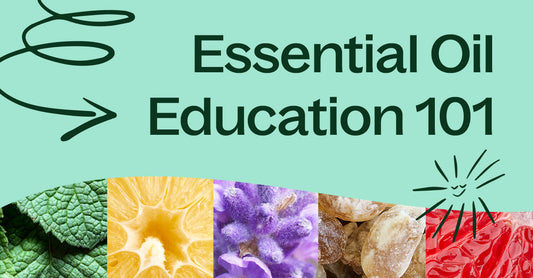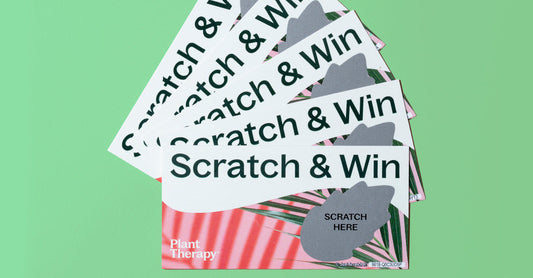This time of the year, it’s no secret that most of us could use a little extra rest and relaxation. Holiday plans and family get-togethers can be very fun, but also very exhausting, taking a pretty significant toll on both our mental and physical health. Thankfully, we can turn to our very helpful friend, chamomile, to give us some extra support to help tackle this festive season!
But there’s more than one Chamomile!
Plant Therapy carries two different chamomile essential oils and one Chamomile CO2, which may come off as a bit confusing – understandably. Let’s take some time to clear up the differences so that you can make the most educated decision for yourself and your family.
 Chamomile Roman, Chamaemelum nobile, and Chamomile German, Matricaria chamomilla, are both aromatic herbs often used interchangeably. However, you’ll notice that both of these “chamomiles” have a different genus and species name; they also have markedly different chemical components and can be used for different purposes.
Chamomile Roman, Chamaemelum nobile, and Chamomile German, Matricaria chamomilla, are both aromatic herbs often used interchangeably. However, you’ll notice that both of these “chamomiles” have a different genus and species name; they also have markedly different chemical components and can be used for different purposes.
Chamomile Roman

The Chamaemelum nobile is a small evergreen perennial that grows low to the ground. The hairy stems and threadlike leaves support small, vibrant, daisy-like flowers that often create a gorgeous ground cover. The essential oil has a pale, yellow color and a light, but intense, sweet apple-fruity aroma. This is widely considered the more gentle chamomile oil, making it ideal for use with young children.
It has long been favored to help calm the nervous system and provide support for feelings of irritability, anxiety, and stress . Chamomile Roman is also a fantastic choice to help improve the quality of sleep by easing physical and emotional tension in the body that can build up over time . This natural mood booster can also help reduce feelings associated with depression . Perfect for the holidays, right?
Chamomile Roman is rich in esters, which gives this oil its antispasmodic qualities. This is ideal when you’re dealing with a tummy that feels tight and uncomfortable. It helps relax stomach muscles, which consequently can dispel gas and support the digestive processes . This is also great for soothing menstrual cramps, body aches, and back pain associated with a woman’s menses .
This gentle giant of an oil can also provide soothing relief to irritated skin. It has been used as a natural remedy for dry skin, superficial wounds, and minor burns, bruises, and rashes . For an amazing facial mask DIY using Chamomile Roman, check out THIS blog!
Chamomile German

The Matricaria chamomilla is a self-seeding annual plant with long, branching, hairless stems that can grow up to 24 inches tall. The vibrant yellow and white flowers are steam distilled to produce a strong, herbaceous aroma similar to chamomile tea. The essential oil is a breathtakingly deep and distinct blue color, thanks to its chamazulene content. So be careful – this oil will leave a stain on fabric and carpet!
Chamomile German is rich in sesquiterpene derivatives. Particularly, the chemical components a-bisabolol and azulene are known to stimulate the liver and support the digestive system by easing intestinal cramping .
Inhaling Chamomile German has shown to reduce the perception of pain, ease tired muscles and aching joints, and can also assist with nasal allergies, minor cuts, and superficial wounds . Additionally, it is emotionally and mentally calming, helping to settle frayed nerves and ease tension after a long day .
Check out THIS blog for a DIY cream using Chamomile German that will help give you a well-rested night of sleep!
Chamomile German CO2

The CO2 Extract version of Chamomile German has a softer, more herbaceous aroma that is considered “truer” to the scent of the flower. A difference from steam distilled Chamomile German that you may notice immediately is the CO2’s lack of color. That’s because chamazulene, the component that gives Chamomile German that beautiful blue color, develops during the steam distillation process.
However, unlike the steam distilled version, the CO2 contains Matricine, a component that is the precursor to chamazulene. This is known to be very supportive, especially for dry or reddened skin. This is a fantastic choice for helping soothe skin inflammations, such as minor rashes, insect bites, and burns.
Keep in mind that this CO2 can be a little tricky to work with because it is very thick and viscous. Just roll the bottle in your hand to create warmth and allow the CO2 to be a bit more workable. You only need a very small amount of it, too — just 0.1 – 0.2% for skin blends — because it is such a powerhouse.
Check out some great recipes for skin using Chamomile German CO2 HERE!
Sources:
Study shows chamomile capsules ease anxiety symptoms. (2015). National Center for Complementary and Integrative Health. Retrieved from https://nccih.nih.gov/research/results/spotlight/040310.htm
Amsterdam, J. D., Shults, J., Soeller, I., Mao, J. J., Rockwell, K., & Newberg, A. B. (2012). Chamomile (Matricaria recutita) may provide antidepressant activity in anxious, depressed humans: an exploratory study. Alternative therapies in health and medicine, 18(5), 44-9.
Guimarães, R., Barros L., Dueñas, M., Calhelha, R., Carvalho, A., Santos-Buelga, C., Queiroz, M., Ferreira, I. (2013). Nutrients, phytochemicals and bioactivity of wild Roman chamomile: a comparison between the herb and its preparations. Retrieved from https://www.ncbi.nlm.nih.gov/pubmed/23122119
Srivastava, J.K., Shankar, E., & Gupta, S. (2010). Chamomile: A herbal medicine of the past with a bright future (Review). Molecular Medicine Reports, 3, 895-901.
Butje, A. (2016). Should You Use Roman Chamomile or German Chamomile? Retrieved from https://blog.aromahead.com/2016/05/16/use-roman-chamomile-german-chamomile
Amsterdam, J., Shults, J., Soeller, I., Mao J., Rockwell, K., Newberg, A. (2012). Chamomile (Matricaria recutita) may provide antidepressant activity in anxious, depressed humans: an exploratory study. Retrieved from https://www.ncbi.nlm.nih.gov/pubmed/22894890
Chamomile. National Center for Complementary and Integrative Health. Retrieved from https://nccih.nih.gov/health/chamomile/ataglance.htm
Srivastava, J. K., Shankar, E., & Gupta, S. (2010). Chamomile: A herbal medicine of the past with bright future. Molecular medicine reports, 3(6), 895-901.
Chamomile.(2018). Michigan Medicine University of Michigan. Healthnotes, Inc. Retrieved from https://www.uofmhealth.org/health-library/hn-2066005
Ford-Martin, P. and Odle, T. G. 2005. Aromatherapy. In J.L. Longe, ed. Gale Encyclopedia of Alternative Medicine. Second Edition, Volume I (A–C). Farmington Hills, MI: Thomson Gale, p. 123.









